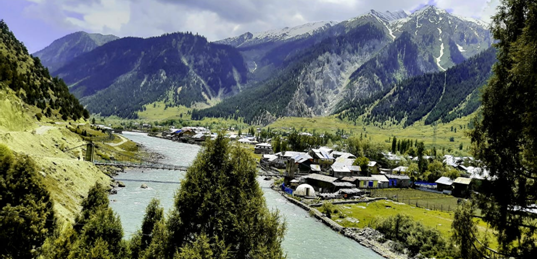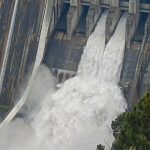The Kishanganga River, a remarkable 245-kilometer-long watercourse, originates in the Ganderbal district of Jammu and Kashmir near the Krishansar Lake, close to the well-known tourist destination of Sonamarg. This river, known for its captivating journey through the picturesque valleys of Kashmir, covers 50 kilometers in Kashmir, with the remaining 195 kilometers flowing through Pakistan Occupied Kashmir. From its origin at Sonamarg, the Kishanganga River flows northwards through the Tulail and Gurez Valleys of India before entering Pakistan Occupied Kashmir at the village of Tarabal in the Baktoor sector. Upon crossing the Line of Control (LoC) at Taobat in Neelum District, the river is renamed Neelum by Pakistan since 1956. Historical references to the river include names like Sindhu in Kalhana’s Rajatarangini and Kishenganga as mentioned by M.A. Stein. Throughout its journey, the river forms the LoC at several points in Kupwara district and Bandipora’s Gurez Valley, finally merging with the Jhelum River near Muzaffarabad, the capital of Pakistan-Occupied Kashmir.
The Kishanganga River is enriched by numerous tributaries, including the Raman Sind, the Burzil stream, the Machil, the Kel Dara, the Kankatori (Samgan), and the Jagran River. These tributaries enhance the lush green valleys and unique geography through which the river flows. The Kishanganga River holds immense religious significance for Hindus, particularly with sites like Krishansar Lake and Sharada Peeth. Sharada Peeth, situated in the Neelum Valley of Pakistan Occupied Kashmir, is an ancient temple and learning center revered by the Kashmiri Pandit community. The temple, along with the adjacent ruins of Sharada University, was among the most prominent temple universities between the 6th and 12th centuries CE.
The river is home to a diverse ecosystem, including various fish species such as Brown trout, Rainbow trout, Snow trout, Shuddgurn, and Anyour. The sparse human settlements along the riverbanks, due to proximity to the LoC and regional uncertainty, allow the river’s ecosystem to thrive. Balancing development with ecological preservation is crucial, especially as India and Pakistan continue to invest in hydroelectric projects on the Kishanganga River. The Indus Waters Treaty, signed in 1960 between India and Pakistan, governs the usage and distribution of water from the Indus River system. It grants Pakistan control over the Indus, Chenab, and Jhelum rivers, while India controls the Beas, Ravi, and Sutlej rivers.
However, India is allowed to use the western rivers, including the Kishanganga River, for non-consumptive purposes like hydroelectric projects. The 330 MW Kishanganga Hydroelectric Plant, inaugurated by Prime Minister Narendra Modi in 2018, generates 1,713 million units of electricity annually. This project faced objections from Pakistan, which claimed it violated the Indus Waters Treaty. The matter was resolved by the Court of Arbitration of the World Bank. In response, Pakistan constructed the 969 MW Neelum-Jhelum Hydropower Plant with assistance from a Chinese consortium.
Tourist Spots along the Kishanganga River
The areas along the Kishanganga River are now emerging as unique tourist destinations, despite their historical use as infiltration corridors and conflict zones. The concept of border tourism is now a reality.
Tulail Valley, a sub-valley of Gurez, offers striking landscapes, rich vegetation, and abundant wildlife. Located 120 kilometers northeast of Bandipora and 200 kilometers from Srinagar, it is a perfect escape for nature enthusiasts.
Gurez Valley, traversed by the Kishanganga River, is renowned for its natural beauty and cultural heritage. Situated 86 kilometers from Bandipora and 123 kilometers from Srinagar, it features snow-capped mountains and the historic Razdan Pass. The valley’s people, the ethnic Dards, share cultural ties with those in Gilgit-Baltistan.
Bagtoor, part of Gurez Valley, marks the river’s entry into the Neelum Valley. The last village on the Indian side is Tarabal, with Taobat on the Pakistani side.
Keran Valley, divided by the LoC, is home to beautiful streams, springs, and dense forests. The village is accessible through Firkiyan Gali, offering mesmerizing views. The historic wooden architecture is a highlight, with many homes left abandoned after the partition.
Teetwal, situated on the riverbanks near the LoC, has a rich history as a trade hub along the Silk Road. The iconic Teetwal crossing bridge, built in 1931, now stands as a symbol of division. The area also hosts a reconstructed temple serving as a base camp for pilgrims en route to Sharada Peeth.
The Kishanganga River, with its rich history, stunning landscapes, and religious significance, is a valuable natural and cultural asset. Cooperation between India and Pakistan is essential to ensure its sustainable and equitable management for the benefit of both people and the environment.
(Author, is Content Director of the Magazine “The North Kashmir Gazette” promoting the offbeat tourist destinations of North Kashmir. He can be reached at [email protected])








